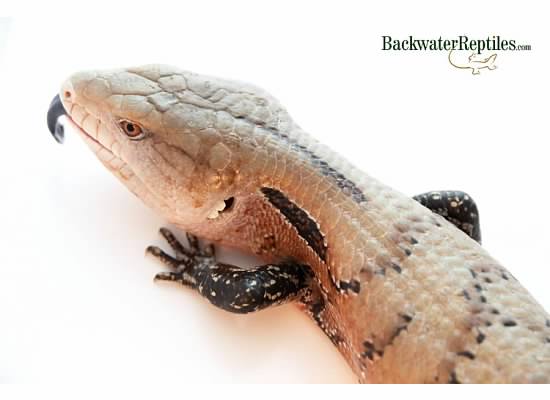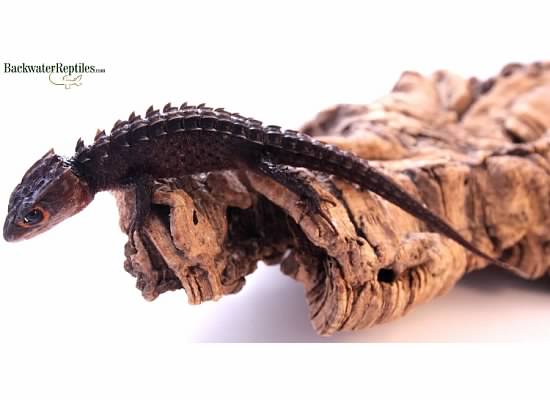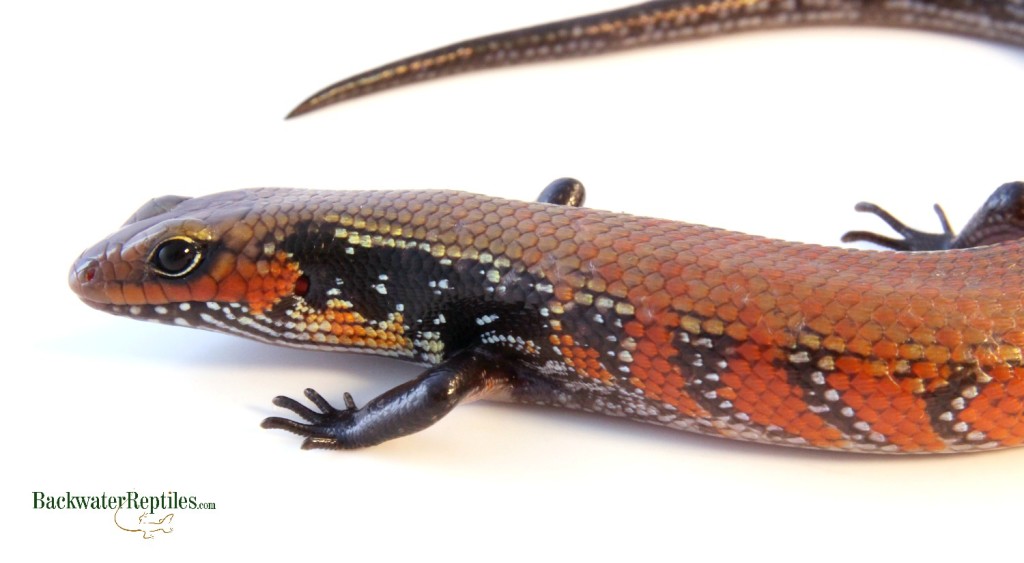Skinks are sleek, smooth and generally docile lizards. Most will attain a very reasonable size and have straightforward care requirements. We’re very fond of skinks in general and think they make tremendously rewarding and entertaining reptile companions.
Backwater Reptiles list: the best pet skinks
Blue Tongue Skink (Tiliqua sp.)
Probably the most popular pet skink we sell at Backwater Reptiles would be the Blue Tongue. “Blueys,” as they are affectionately known amongst herp hobbyists, are also the largest skink species (aside from the much harder to come by Solomon Island Skink) sold by Backwater Reptiles.

We recommend purchasing your bluey as a hatchling because you can watch it grow up and train it to recognize you. The more you interact with your bluey, the more docile and tame it will become. Many will sit on the couch with their owner or even hang out on their owner’s shoulders like a parrot.
Of all the skink species sold by Backwater Reptiles, we’d say that blueys are probably the hardiest and most interactive. As we already mentioned, you can train them to enjoy being handled and petted, which is great if you want a lizard that you can “play” with, so to speak.
Blueys are omnivores and will need a varied diet ranging from canned or cooked meat to fresh, leafy greens and veggies.
If you want a pet blue tongue skink of your own, Backwater Reptiles has healthy babies and adults available.
Red Eye Crocodile Skink (Tribolonotus gracilis)
Many people are attracted to red eye croc skinks because they are reminiscent of tiny little dragons. They have heavily keeled scales, fierce pointy heads, and eyes that are ringed in a very bright orange/red color. Add some miniature wings and – voila! – you’ve got the world’s tiniest dragon.
Aside from their physical appearance, croc skinks are generally pretty docile. They don’t mind being picked up and human interaction doesn’t phase them.

Your pet croc skink will grow to be around six or seven inches long, which makes them a very manageable size. A single croc skink will only need an enclosure ten to twenty gallons in size. We recommend going with the 20 gallon if you plan to keep a mating pair together.
Want to know an interesting factoid about the red eye crocodile skink? These skinks are actually capable of making low yelping or squeaking noises. Hatchlings and adults can make the sounds, so don’t be alarmed if you hear a strange noise from your croc skink’s home. With the exception of geckos, this behavior is very unusual in lizards.
Interested in your own little wingless dragon skink? We’ve got red-eyed crocodile skinks for sale.
Fire Skink (Riopa fernandi)
If you haven’t already guessed as much, fire skinks get their common name from their bright red/orange coloration. Like nearly all skinks, they have very smooth scales with stout legs and thick heads and tails. They stay very low to the ground and spend most of their time burrowing and hiding.
Fire skinks are carnivorous and should be fed a staple diet of crickets with mealworms, reptiworms, hornworms, and roaches to supplement and provide nutritional variety. It’s always wise to provide a light-weight water dish too, even if fire skinks are not particularly avid drinkers.

Your pet fire skink should live for around fifteen to twenty years. A mature adult can grow to be fourteen or fifteen inches long, so we recommend a glass enclosure that is at least twenty gallons in size. If you wish to keep a mating pair together, we recommend a slightly larger home as these are actually pretty active lizards.
Backwater Reptiles has fire skinks for sale if you’re ready to welcome one into your own home.
Blue Tail Skink (Mabuya quinquetaeniata)
The smallest skink on our list is the Blue Tail Skink, which is also known as the Five-Lined Skink. This skink gets both of its common names from both its blue tail and the five cream-colored lines on its back and sides.
These little lizards are quite fast and thoroughly enjoy hiding. We recommend investing in a good substrate since your skink will spend a great deal of time out of sight. You can keep a single one in an enclosure as small as a plastic shoebox, although we always recommend at least a ten gallon tank.

The Blue Tail will eat anything you provide for it. They’re not usually very picky. We recommend crickets and roaches with occasional treat insects like reptiworms or wax worms.
It should be noted that of all the skink species on this list, the blue tail is the least likely to enjoy being taken out of its enclosure to be held. They are known for being a bit skittish, so if you plan to handle your blue tail a lot, be prepared to train it.
Get your very own blue tail skink from Backwater Reptiles!
The best pet skinks: Conclusion
Skinks as a species are a great pet choice for any reptile enthusiast. They all adapt well to captivity and are easy to care for. They live fairly long lives and are great for kids and adults alike. They also make awesome classroom pets.
